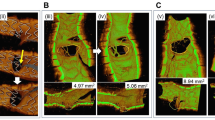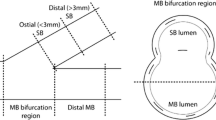Abstract
The present study investigated serial changes in the three-dimensional (3D) aspect of the jailed side-branch (SB) ostium. We evaluated 32 patients who underwent examination with optical coherence tomography (OCT) both at baseline and at follow-up. After reconstruction of the 3D images, we classified the configuration of overhanging struts at the SB orifice into three groups according to the 3D aspect of the jailing configuration. The number of compartments divided by the stent strut was counted. The side-branch flow area (SBFA), i.e., the area of the SB ostium except for jailing struts, was measured by cut-plane analysis. Forty-eight SBs of 25 patients were analyzed. Thirteen SBs were classified as the No-jail type (N-type), 19 as the Simple-jail type (S-type; no longitudinal link at the carina), and 16 as the Complex-jail type (C-type; had a link at the carina). In the N-type, the SBFA was significantly increased at follow-up (P = 0.018). In the C-type, the SBFA was significantly decreased at follow-up (P = 0.002). Percent reduction of SBFA in the C-type group was significantly greater than that in the N-type or S-type groups (S-type vs. C-type P = 0.002, N-type vs. C-type P < 0.001). 3D-OCT images showed that some of the compartments were filled with tissue. The number of compartments was significantly decreased at follow-up (P < 0.001). In the C-type group, the SBFA was significantly decreased and small compartments were filled with tissue. These findings suggest that stent jail complexity is associated with the progression of SB ostial stenosis.







Similar content being viewed by others
References
Sarno G, Garg S, Onuma Y, Girasis C, Tonino P, Morel MA, van Es GA, Pijls N, Serruys PW (2010) Bifurcation lesions: functional assessment by fractional flow reserve vs. anatomical assessment using conventional and dedicated bifurcation quantitative coronary angiogram. Catheter Cardiovasc Interv 76:817–823
Ahn JM, Lee JY, Kang SJ, Kim YH, Song HG, Oh JH, Park JS, Kim WJ, Lee SW, Lee CW, Kim JJ, Park SW, Park SJ (2012) Functional assessment of jailed side branches in coronary bifurcation lesions using fractional flow reserve. J Am Cardiol Interv 5:155–161
Yamawaki M, Muramatsu T, Araki M, Hirano K, Nakano M, Ishimori H, Ito Y, Murasato Y, Ueno T, Tsukahara R (2012) Natural history of side branches jailed by drug-eluting stents. J Interv Cardiol 25(1):37–46
Lee BK, Kim YH, Park DW, Yun SC, Ahn JM, Song HG, Lee JY, Kim WJ, Kang SJ, Lee SW, Lee CW, Lee JH, Seong IW, Park SW, Park SJ (2012) Acute and long-term angiographic outcomes of side branch stenosis after randomized treatment of zotarolimus-, sirolimus-, and paclitaxel-eluting stent for coronary artery stenosis. J Korean Med Sci 12:1499–1506
Poerner TC, Kralev S, Voelker W, Sueselbeck T, Latsch A, Pfleger S, Schumacher B, Borggrefe M, Haase KK (2002) Natural history of small and medium-sized side branches after coronary stent implantation. Am Heart J 143:627–635
Tanabe K, Serruys PW, Degertekin M, Regar E, van Domburg RT, Sousa JE, Wülfert E, Morice MC (2002) Fate of side branches after coronary arterial sirolimus-eluting stent implantation. Am J Cardiol 90:937–941
Lee SY, Kim JS, Shin DH, Kim BK, Ko YG, Choi D, Jang Y, Hong MK (2012) Serial optical coherence tomography-based observation of strut coverage on drug-eluting stent crossing side-branch vessels. J Invasive Cardiol 11:569–573
Kyono H, Guagliumi G, Sirbu V, Rosenthal N, Tahara S, Musumeci G, Trivisonno A, Bezerra HG, Costa MA (2010) Optical coherence tomography (OCT) strut-level analysis of drug-eluting stents (DES) in human coronary bifurcations. EuroIntervention 6(1):69–77
Farooq B, Serruys PW, Heo JH, Gogas BD, Okamura T, Gomez-Lara J, Brugaletta S, Garcìa-Garcìa HM, van Geuns RJ (2011) New insights into the coronary artery bifurcation hypothesis-generating concepts utilizing 3-dimensional optical frequency domain imaging. JACC Cardiovasc Interv 4(8):921–931
Tateishi H, Okamura T, Yamada J, Nao T, Maeda T, Oda T, Nakamura T, Miura T, Matsuzaki M, Yano M (2014) Sequel of jailed side branch. Circ J 78(3):772–774
Okamura T, Onuma Y, Hecter M, Garcia-Garcia HM, Regar E, Wykrzykowska JJ, Koolen J, Thuesen L, Windecker S, Whitbourn R, McClean DR, Ormiston JA, Serruys PW, ABSORB Cohort B Investigators (2010) 3-Dimensional optical coherence tomography assessment of jailed side branches by bioresorbable vascular scaffolds. JACC Cardiovasc Interv 3(8):836–844
Karanasos A, Tu S, van Ditzhuijzen NS, Ligthart JM, Witberg K, Van Mieghem N, van Geuns RJ, de Jaegere P, Zijlstra F, Reiber JH, Regar E (2015) A novel method to assess coronary artery bifurcations by OCT: cut-plane analysis for side-branch ostial assessment from a main-vessel pullback. Eur Heart J Cardiovasc Imaging 16(2):177–189
Tu S, Jing J, Holm NR, Onsea K, Zhang T, Adriaenssens T, Dubois C, Desmet W, Thuesen L, Chen Y, Reiber JH (2012) In vivo assessment of bifurcation optimal viewing angles and bifurcation angles by three-dimensional (3D) quantitative coronary angiography. Int J Cardiovasc Imaging 28:1617–1625
Ha J, Kim JS, Mintz GS, Kim BK, Shin DH, Ko YG, Choi D, Jang Y, Hong MK (2014) 3D OCT versus FFR for jailed side-branch ostial stenoses. JACC Cardiovasc Imaging 7(2):204–205
Diletti R, Farooq V, Muramatsu T, Gogas BD, Garcia-Garcia HM, van Geuns RJ, Serruys PW (2012) Serial 2- and 3-dimensional visualization of side branch jailing after metallic stent implantation: to kiss or not to kiss? JACC Cardiovasc Interv 5(10):1089–1090
Bland JM, Altman DG (1986) Statistical methods for assessing agreement between two methods of clinical measurement. Lancet 1(8476):307–310
Alfonso F, Hernández C, Pérez-Vizcayno MJ, Hernández R, Fernández-Ortíz A, Escaned J, Bañuelos C, Sabaté M, Sanmartín M, Fernández C, Macaya C (2000) Fate of stent-related side branches after coronary intervention in patients with in-stent restenosis. J Am Coll Cardiol 36(5):1549–1556
Yang PS, Ha J, Kim JS, Park S, Bae J, Shin DH, Kim BK, Ko YG, Choi D, Jang Y, Hong MK (2015) Eccentric morphology of jailed side-branch ostium after stent crossover in coronary bifurcation lesions: a three-dimensional optical coherence tomographic analysis. J Cardiol 65(4):305–310
Hahn JY, Chun WJ, Kim JH, Song YB, Oh JH, Koo BK, Rha SW, Yu CW, Park JS, Jeong JO, Choi SH, Choi JH, Jeong MH, Yoon JH, Jang Y, Tahk SJ, Kim HS, Gwon HC (2013) Predictors and outcomes of side branch occlusion after main vessel stenting in coronary bifurcation lesions: results from the COBIS II Registry (Coronary Bifurcation Stenting). J Am Coll Cardiol 62(18):1654–1659
Liu Y, Imanishi T, Kubo T, Tanaka A, Kitabata H, Tanimoto T, Ino Y, Ikejima H, Tsujioka H, Komukai K, Ishibashi K, Kashiwagi M, Ozaki Y, Hirata K, Mizukoshi M, Akasaka T (2011) Assessment by optical coherence tomography of stent struts across side branch. Comparison of bare-metal stents and drug-elution stents. Circ J 75(1):106–112
Gutiérrez-Chico JL, Regar E, Nüesch E, Okamura T, Wykrzykowska J, di Mario C, Windecker S, van Es GA, Gobbens P, Jüni P, Serruys PW (2011) Delayed coverage in malapposed and side-branch struts with respect to well-apposed struts in drug-eluting stents: in vivo assessment with optical coherence tomography. Circulation 124(5):612–623
Her AY, Ann SH, Singh GB, Kim YH, Okamura T, Garg S, Koo BK, Shin ES (2016) Serial morphological changes of side-branch ostium after paclitaxel-coated balloon treatment of de novo coronary lesions of main vessels. Yonsei Med J 57:606–613
Welt FG, Rogers C (2002) Inflammation and restenosis in the stent era. Arterioscler Thromb Vasc Biol 22(11):1769–1776
Shin DH, Koo BK, Waseda K, Park KW, Kim HS, Corral M, Lansky A, Honda Y, Fearon WF, Fitzgerald PJ (2011) Discrepancy in the assessment of jailed side branch lesions by visual estimation and quantitative coronary angiographic analysis: comparison with fractional flow reserve. Catheter Cardiovasc Interv 78(5):720–726
Niemela M, Kervinen K, Erglis A, Holm NR, Maenq M, Nordic-Baltic PCI Study Group et al (2011) Randomized comparison of final kissing balloon dilatation versus no final kissing balloon dilatation in patients with coronary bifurcation lesions treated with main vessel stenting: the Nordic-Baltic Bifurcation Study III. Circulation 123:79–86
Hariki H, Shinke T, Otake H, Shite J, Nakagawa M, Inoue T, Osue T, Iwasaki M, Taniguchi Y, Nishio R, Hiranuma N, Kinutani H, Konishi A, Hirata K (2013) Potential benefit of final kissing balloon inflation after single stenting for the treatment of bifurcation lesions–insights from optical coherence tomography observations. Circ J 77(5):1193–1201
Okamura T, Yamada J, Nao T, Suetomi T, Maeda T, Shiraishi K, Miura T, Matsuzaki M (2011) Three-dimensional optical coherence tomography assessment of coronary wire re-crossing position during bifurcation stenting. EuroIntervention 7:886–887
Acknowledgements
The funding was provided by JSPS KAKENHI (Grant No. 26461071).
Author information
Authors and Affiliations
Corresponding author
Ethics declarations
Conflict of interest
None of the authors have conflicts of interest to declare in relation to this investigation.
Ethical standards
The Medical Ethics Committee at our institution approved this study protocol, and written informed consent was obtained from all patients before participation.
Rights and permissions
About this article
Cite this article
Nakamura, T., Okamura, T., Fujimura, T. et al. Serial changes in the three-dimensional aspect of the side-branch ostium jailed by a drug-eluting stent assessed by optical coherence tomography. Int J Cardiovasc Imaging 33, 797–806 (2017). https://doi.org/10.1007/s10554-017-1080-8
Received:
Accepted:
Published:
Issue Date:
DOI: https://doi.org/10.1007/s10554-017-1080-8




